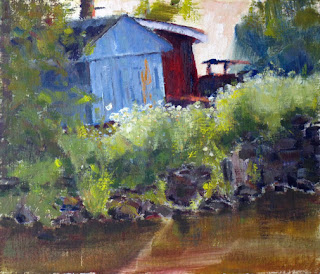A number of artists have added "tools" to their depth creating efforts. These include Giorgione, Titian, Monet, Cezanne, Hawthorne, Hensche, and Payne.
According to Hawthorne and Hensche, Monet found that every plane change has an associated colour change. They modelled depth using colour instead of drawing type value change. This suited Monet who was primarily interested in light effects on colour.
Cezanne eventually developed a system that included the picture plane as part of the structure of the painting. He created depth by employing visible lines (including outlines) and overlapping planes. He often painted over these lines. These planes were not required to diminish in size according to scientific perspective. Here are a few examples.
Movement into Depth
No Outlines - Movement into Depth
Linear Perspective
Here the eye is lead into deep space where it drops out of the picture. Cezanne wished to control this or eliminate it. This is standard perspective. He did a number of things to avoid this. We can discuss this later. Meanwhile, one can apply these ideas to all genres including the landscape.
Similar Values
Here we have a "tree" in front of some overlapping "rocks". Substitute what you like for these elements. The colour temperature of the other shapes indicate depth without greying or value change. No question there is depth, and the eye doesn't drop off the back. The image is flatteded and is in concert with the 2D picture plane. These concepts had many implications in modern art, all espoused by Hans Hoffman and employed by Picasso and Matisse et al. Variations on a theme. Individual tools for the kit box to be used as deemed fit. These are not either or, they can be mixed and matched.
Tree with Rocks in a Stream Bed
Here the planes are tilted on their sides as if looking at a slip shod set of patio stones. Dynamic. Notice the planes used in the first examples. They are drawn by hand. Much more interesting than those done by ruler. Just like nature!





























